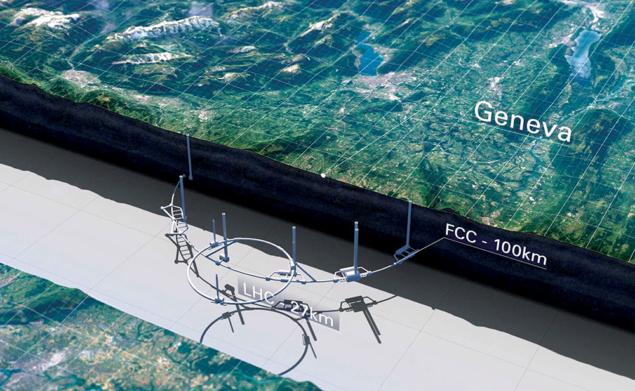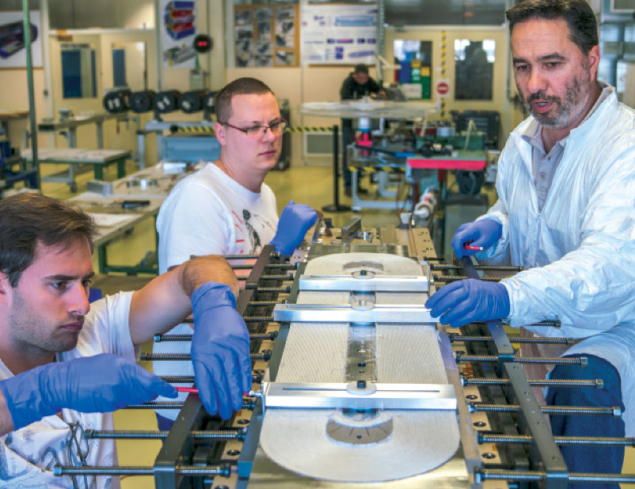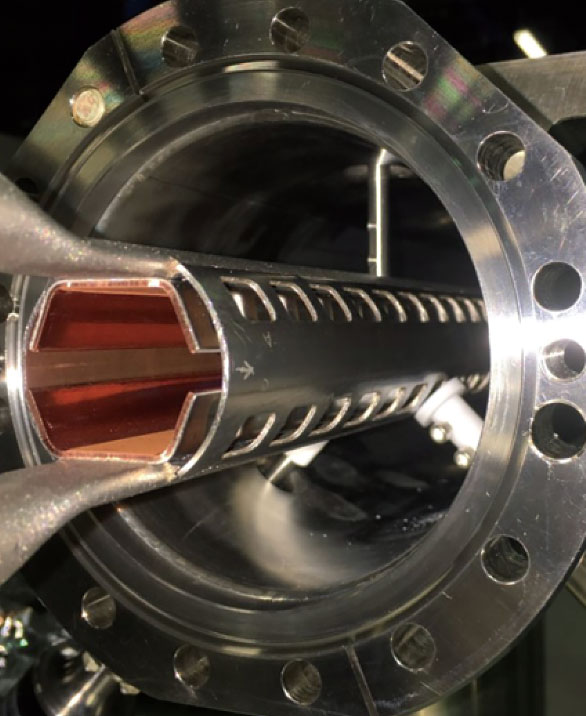Going from the LHC to a 100 km-circumference supercollider is a daunting challenge, but the community has made similar jumps in the past – and the future of fundamental exploration is at stake.

Particle physics has revolutionised our understanding of the universe. The experimental and theoretical tools developed in the 20th century delivered the Standard Model of particle physics, the particle content of which was completed in 2012 with the discovery of the Higgs boson at the LHC. And, yet, this hugely powerful theory leaves several observations unexplained. In solving mysteries such as the nature of dark matter, the origin of neutrino masses, the dominance of matter over antimatter on cosmological scales, and the low mass of the Higgs boson itself, physicists could open a completely new view of nature. Therefore, it is high time to start planning a new collider that maintains this rich course of exploration throughout the 21st century.
In late 2018 the Future Circular Collier (FCC) collaboration published a conceptual design report (CDR) addressing this need. A similar proposal is also under development in China (CERN Courier June 2018 p21). In more than 1000 pages distributed over four volumes, the FCC CDR covers all aspects of the project, including technologies, detector design, physics goals and civil-engineering considerations. But what changes when we move from a 27 km to a new 100 km-long tunnel, and what stays the same? The obstacles to new colliders pushing the current energy and intensity frontiers are many, yet the past five years have seen the international FCC study steadily break them down.
Lessons learned
The FCC design report shows that CERN’s existing accelerator chain can serve as the foundation for a 100 km post-LHC machine, while also opening a rich fixed-target programme. The new 100 km infrastructure is indeed enormous, representing a four-fold increase in dimensions compared to the LHC. But, taking history as a guide, it should be possible: this jump in scale is identical to that adopted in the 1980s to move from the Super Proton Synchrotron (SPS) to the Large Electron Positron collider (LEP) and eventually to the LHC, allowing the completion of the Standard Model. Jumping to larger and more complex machines always comes with new challenges, but these translate precisely into opportunities for young researchers and industry (CERN Courier September 2018 p51).

A 100 km tunnel offers three main collider options. The most straightforward in terms of technological readiness is a luminosity-frontier lepton collider (FCC-ee) that will deliver unprecedented collision rates in a clean environment at specific energies corresponding to the Z pole (91 GeV), the WW threshold (161 GeV), Higgs production (240 GeV), and the top quark–antiquark threshold (350 to 365 GeV). By filling the FCC tunnel with new superconducting magnets twice the strength of the LHC’s (16 T as opposed to 8 T), however, a hadron collider called FCC-hh can be built with a collision energy of 100 TeV – an order-of-magnitude higher than the LHC. The FCC study, which was formally launched in early 2014, also explores the option of a proton–electron collider (FCC-he) that could run in parallel with FCC-hh, and a high-energy LHC based on high-field magnets installed in the current LHC tunnel (CERN Courier June 2018 p15).
The cost of future colliders is a major issue, and concerted value-engineering of all aspects from individual components through sustainability to logistics is required. Cost estimates for FCC construction and operation are detailed in the CDR, although the range of collider modes, staging approaches and technology choices make it difficult to place a single figure on each machine. Construction on a site with an existing infrastructure, as offered by CERN, is a major cost advantage in terms of capital investment, sharing of infrastructure and breadth of the overall physics programme. The sequence of FCC-ee and FCC-hh would also resemble the successful staging of LEP and the LHC: a lepton–lepton machine followed by a hadron collider (both for protons and heavy ions). In the case of the FCC, possibly even a future muon collider could then follow as a third stage.

FCC-ee is a dream machine for precision measurements, taking the successful LEP scheme into entirely new territory (figure 1). Precise measurements of the properties of the Z, W and Higgs boson and the top quark, together with much improved measurements of other input parameters to the Standard Model such as the electromagnetic and strong coupling constants, would provide sensitivity to new particles with masses in the range 10–70 TeV.
Common lattice
The bulk of FCC-ee will comprise around 8000 normal-conducting low-power and cost-effective twin-aperture dipole magnets, 3000 focusing magnets and between 26 (Z pole) and 161 (tt̅ threshold) four-cavity radio-frequency (RF) cryomodules, to compensate for the energy loss from synchrotron radiation and provide the required accelerating voltage. Currently, two interaction points are planned for high-luminosity FCC-ee operations, though up to four can be accommodated. A common FCC-ee lattice has been designed for all energy stages except for the highest energy tt̅ threshold, where a small rearrangement of the beamline passing through the RF cavities will be needed. The basic cell of the FCC-ee lattice has been chosen for operation at a beam energy of 182.5 GeV and combines four dipole magnets and two main quadrupoles in a 50 m-long section. Moreover, to achieve the required high luminosities, the vertical beta function at the interaction points (called βy*) has to be very small (0.8 mm) at the Z pole, which is 50 times smaller than for LEP but about three times larger than for the SuperKEKB accelerator now being commissioned in Japan. The reduction in βy* is possible because of technological innovations during the past three decades (such as local chromatic correction of the final-quadrupole doublet and use of a crab-waist collision scheme) and thanks to the large size of the ring.

Indeed, achieving the unprecedented FCC-ee luminosity of up to 4 × 1036 cm–2s–1 (the total for two experiments), while minimising the amount of synchrotron radiation near the detector, called for considerable effort in designing the final-focus system. Combined with a small crossing angle of 30 mrad, the minimum distance from the interaction point to the first quadrupole is 2 m, which is a compromise between beam dynamics and detector constraints. The present optics design has a momentum acceptance of around 2%, which is one of the most critical requirements of the FCC-ee design because it determines the beam lifetime.
A distinct feature of FCC-ee, in contrast to LEP, is the use of separate beam pipes for the two counter-rotating electron and positron beams, based on energy-efficient dual-aperture main magnets (pictured above). The two separate rings allow operation with a large number of bunches – up to around 16,000 at the Z pole – by avoiding parasitic collisions. This approach also allows for a well-centered orbit all around the ring and a nearly perfect mitigation of the energy “sawtooth” at the highest tt̅ energies. A so-called tapering scheme is foreseen, which will enable the strengths of all the magnets to be scaled according to the local energy of the electron and positron beams, taking into account any differences in the energy loss due to synchrotron radiation. Also distinct from LEP, a top-up injection scheme has been designed for FCC-ee to maximise the integrated luminosity, whereby electrons and positrons are injected into the machine by a full-energy booster to maintain a constant high beam current.
Beating the fourth power
When moving to a larger radius and higher energies, one of the key obstacles for colliders is the synchrotron radiation emitted by the accelerated particles because the resulting energy loss increases with the fourth power of a charged particle’s energy. Improving energy efficiency is critical for any future big accelerator, and the development of high-efficiency RF power sources, along with robust higher-gradient superconducting cavities, is at the core of the FCC programme. The cavities can be produced, for example, by applying a thin superconducting film on a copper substrate, as is currently being pursued by CERN in collaboration with global partners (CERN Courier May 2018 p26). To achieve a low power consumption and guarantee sustainable operation, a high conversion efficiency from wall-plug to RF power is critical. The FCC target RF operation efficiency is 65%, profiting from recent innovations in klystron design at CERN.
For FCC-ee to fulfil its promise of precision electroweak measurements, it is also vital that physicists can accurately determine its centre-of-mass energy so that the Z mass can be measured with a relative precision of 3 × 10–5, the total Z width with a precision of 0.1 MeV and the W mass within 0.5 MeV. A strategy based on the resonant-depolarisation technique, as used at LEP, guarantees precise energy measurements every 15-20 minutes for both the electron and positron beam.
The design of the FCC-ee detectors is also described in the FCC design report. Due to the beam crossing angle, the detectors’ solenoid magnetic field is limited to 2 T to confine their impact on the luminosity due to the synchrotron radiation emitted within the solenoid field. Two detector concepts have been optimised for the FCC-ee: CLD, a consolidated option based on the detector developed for CLIC, with a silicon tracker and a 3D-imaging highly-granular calorimeter; and IDEA, a bolder, possibly more cost-effective, design, with a short drift-wire chamber and a dual-readout calorimeter. However, specific detector-technology choices will be made at a later date.
Following the operation of FCC-ee, the same tunnel could host a 100 TeV proton collider, FCC-hh. A very large, circular hadron collider is the only feasible approach to reach significantly higher collision energies than the LHC (13-14 TeV) in the coming decades. A 100 TeV collider would offer access to new particles through direct production in the few-TeV to 30 TeV mass range, far beyond the LHC’s reach. It would also provide much higher rates for phenomena in the sub-TeV mass range and therefore much greater precision on key measurements (CERN Courier May 2017 p34).

Within 25 years of operation, FCC-hh could accumulate an integrated luminosity of around 20 ab–1 in each of the two main experiments. FCC-hh also offers the possibility of colliding heavy ions with protons and heavy ions with heavy ions, adding to its physics opportunities. Reaching the physics goals of such a collider requires a machine availability of about 70%, which is comparable to what has been routinely reached with the LHC. Nevertheless, considering the increased machine complexity and the introduction of an additional machine in the injector chain in the FCC baseline scenario, achieving this target availability poses major challenges.
FCC-hh is envisioned to lie adjacent to the LHC and SPS, with two injection insertions so that protons can be injected from either the LHC or SPS tunnel. In the first case, the beam will be injected at an energy of 3.3 TeV from the LHC (which requires, in addition to new transfer lines and extraction systems, some modifications to allow the LHC to be ramped five times faster than today). In the second case, a new superconducting SPS – from which other experiments would also profit – could provide a beam at 1.3 TeV using fast ramping and cost-effective 6 T superconducting magnets. The FCC design report presents a complete lattice for FCC-hh that is consistent with this layout and the required energy reach. The arc lattice consists of around 500 cells each 200 m long and made up of two short, straight sections and 12 cryo-dipoles, comprising one 14 m-long dipole and one 0.11 m-long sextupole corrector. Integrated studies of the lattice performance are ongoing and will inform the final choice for the magnet design, along with considerations of power efficiency and cost.
Reducing costs
The biggest cost in reaching higher energies is that of the magnets. A primary goal of FCC-hh is to build 16 T superconducting magnets that are a factor of three to five times more cost-effective per TeV than those of the LHC. Achieving this goal would impact many accelerator applications outside physics, from medical treatments to food-quality monitoring and energy storage and distribution. The FCC study has recently launched a global conductor R&D programme involving collaborators from the US, Russia, Europe, Japan and Korea to improve the performance of the niobium-tin conductor and to reduce its cost.
The FCC-hh foresees two high-luminosity experiments, for which a key design challenge is to obtain the target values of βy* in the collision points while protecting the detectors and the magnets from the collision debris. Incredibly, FCC-hh will produce a pile-up of up to 1000 events per bunch crossing, compared to around 200 at HL-LHC. Another major challenge for FCC-hh is the beam-dump system to protect the machine components. Each of the two rings will have to reliably abort proton beams with stored energies of around 8 GJ, which is more than an order of magnitude higher than for HL-LHC. Beam extraction at the FCC has to be fast, and the first prototypes of new kicker generator and superconducting septum technologies are now being tested.
Synchrotron radiation is also an issue, since FCC-hh will emit about 5 MW at 100 TeV, and calls for a novel beam screen held at a temperature of 50 K (compared with 5–20 K at the LHC). The FCC-hh beam screen, a prototype of which is shown left, enables cost-effective heat removal and maintains the high quality vacuum while providing shielding from the beam. Finally, cooling the FCC-hh superconducting magnets poses entirely new challenges compared to the LHC. In addition to the higher synchrotron radiation, the cooling system (which, like the LHC will use liquid helium at 1.9 K) will have to cope with higher heat dissipated inside the cold magnets as well as from the cold bore itself. About 100 MW of total cooling power will be required to remove 5 MW of synchrotron radiation heat (see China and Europe bid for post-LHC collider).
Coordinating the future
For almost 90 years, progress in particle physics has gone hand-in-hand with progress in accelerators. Today, capitalising on the great success of the LHC, the field faces pivotal decisions about what collider to build next. Advancing the enabling technologies for a future circular collider can only be done via a coordinated international effort between universities, research centres and industry. It also calls for smart solutions to ensure reliability and sustainability. The results of these efforts are documented in the four volumes of the FCC conceptual design report, which presents a clear route to a post-LHC machine and also serves as an input to the update of the European Strategy for Particle Physics.
The FCC offers great potential for curiosity-driven research with unimaginable consequences. Discoveries of new particles and forces not only alter our perspective of humankind’s position in the universe, but also, either directly or via the technology that made them possible, lead to radical applications that improve our quality of life. In the present age of political turbulence and rapid change, we are proposing an ambitious future accelerator complex to push the boundaries of knowledge and to optimally prepare future generations for the challenges they are sure to face.
Further reading
M Benedikt et al. 2018 CERN-ACC-2018-0058.
M Benedikt et al. 2018 CERN-ACC-2018-0057.
M Mangano et al. 2018 CERN-ACC-2018-0056.
F Zimmermann et al. 2018 CERN-ACC-2018-0059.





